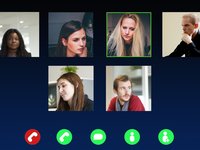5G conferences around the globe took place ...
Bored of back-to-back presentations and panels? Test these (new) formats at your event
Even after thousands and thousands of conferences have taken place, most programmes still look the same, and it goes something like this: Keynote, presentation, panel, presentation, presentation, panel and so on...from the 09:00 start on Day 1 until the 17:00 finish on Day 2 or 3. It’s no wonder that some people, even ahead of going to a conference, think they already know what will be said or refer to it as a monotone or monologue meeting, quite likely because of this standardised format. Could you change this attitude and refresh your event by trying out some new session formats?
Based on our previous experience and further research, here are some ideas to play with:
-
Fishbowl conversation (Unpanel)
A fishbowl conversation is an open discussion that anyone in the audience can participate in. It’s done by having two or three pre-arranged guest panelists, the moderator and adding one extra empty chair.
After the initial introduction of the topic by the moderator, the panelists start discussing. As mentioned, any member of the audience can, at any time, occupy the empty chair and join them. When this happens, an existing member of the fishbowl must voluntarily leave the fishbowl and free up a chair. This exchange of panellists talking can go on until the time is up.
This is a great way to decrease the distinctions between the “official” speakers and the audience and get as many people involved.
-
Knowledge cafe
Another possible way of engaging more delegates at your meetings or discussions is a Knowledge cafe . This session format is led by a facilitator, who begins (much like in a fishbowl conversation) by introducing a topic and posing one or two key open-ended questions.
After the introduction, the group breaks down into smaller groups who start their own discussions.
After the time is up, participants return to their initial positions and the facilitator leads the group through the final 45 minute session, in which attendees reflect on the small group discussions and share any thoughts, insights and ideas on the topic that may have emerged.
-
Body voting
One way of breaking the ice for your session could be body voting, and here’s how it could work:
Example:
“Have everyone stand. Then ask the following questions: If you’ve been in this industry for more than one year, stay standing. Those that haven’t please take a seat. If you’ve been in this industry for more than five years, stay standing. Those that haven’t please sit. Repeat the process until only a few are standing.” - taken from CWEA .
It is a fun way of getting people to move around and on the other hand find out interesting facts about each other. It’s cost-free and potentially quite effective, but it depends on your audience if they will be up for a little bit more exercise!
-
Human spectragram
If you’d like to learn how your audience feels about specific issues or statements, try human spectragram. Apparently it’s “kindergarden level easy” but gets the conversation going. Make a statement while the attendees are standing along one wall,where one corner represents strongly agree and the opposite corner represents strongly disagree.
Again, you get your audience to move around the room and do a bit of exercise!
-
Jigsaw Group Brainstorming
Attendees are divided into separate groups, each with a pre-set topic, facilitator and flip chart. The participants of each group brainstorm the topic they’ve been given, while one of them keeps notes on a flip chart. When the time is up, participants of each group separate and move to another table, where that table’s topic is discussed and the flip chart shared. The facilitator at each table helps start the brainstorming where the previous group ended. At the end, all charts are shared with the attendees.
-
Open Space Session
Often used as problem solving tool, open space session is modelled on the author Harrison Owen’s Open Space Technology . These are variety of meeting formats where participants define the agenda with a rigorous process and contribute to the session, the agenda, the groupings and the topics.
-
Master Classes
Master classes became a natural extension of the keynotes presented during the plenary sessions. These can be popular in situations where your audience is interested in getting a deeper view of a teaser presented in a keynote. To make the masterclass topics more tailored to your audience, you could have a live voting system going on during the keynotes, so the audience would choose on their own (as in format suggestion number 6 above) which topics the masterclasses would focus on.
That’s just a few tips from us, keep reading, learning and reinventing your events to make the whole events industry and each individual event more innovative, interactive and successful!
Source: CWEA
Cover image credit: Office Now
Slider-image credit: Jim Larrison
Return to Posts



